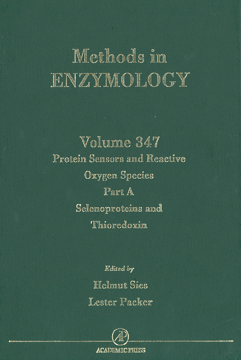
BOOK
Protein Sensors of Reactive Oxygen Species, Part A: Selenoproteins and Thioredoxin
(2002)
Additional Information
Book Details
Abstract
This volume of Methods in Enzymology is concerned with the rapidly developing field of selenoprotein synthesis and its related molecular genetics. Progressive information on the topics of proteins as redox sensors, selenoproteins, and the thioredoxin system is studied using methods such as bioinformatics, DNA chip technology, cell biology, molecular genetics, and enzymology. The information on novel selenoproteins identified from genomic sequence data, as well as current knowledge on glutathione peroxidases, selenoprotein P, iodothyronine deiodinases, and thioredoxin reductases, is presented in a method-based approach.
PRAISE FOR THE SERIES
"The Methods in Enzymology series represents the gold-standard."
—NEUROSCIENCE
"Incomparably useful."
—ANALYTICAL BIOCHEMISTRY
"It is a true 'methods' series, including almost every detail from basic theory to sources of equipment and reagents, with timely documentation provided on each page."
—BIO/TECHNOLOGY
"The series has been following the growing, changing and creation of new areas of science. It should be on the shelves of all libraries in the world as a whole collection."
—CHEMISTRY IN INDUSTRY
"The appearance of another volume in that excellent series, Methods in Enzymology, is always a cause for appreciation for those who wish to successfully carry out a particular technique or prepare an enzyme or metabolic intermediate without the tiresome prospect of searching through unfamiliar literature and perhaps selecting an unproven method which is not easily reproduced."
—AMERICAN SOCIETY OF MICROBIOLOGY NEWS
"If we had some way to find the work most often consulted in the laboratory, it could well be Colowick and Kaplan's multi-volume series Methods in Enzymology...a great work."
—ENZYMOLOGIA
"A series that has established itself as a definitive reference for biochemists."
—JOURNAL OF CHROMATOGRAPHY
